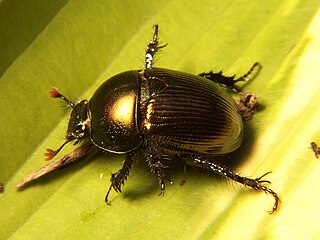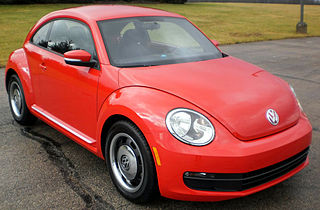
Beetles are a group of insects that form the order Coleoptera, in the superorder Endopterygota. Their front pair of wings are hardened into wing-cases, elytra, distinguishing them from most other insects. The Coleoptera, with about 400,000 species, is the largest of all orders, constituting almost 40% of described insects and 25% of all known animal life-forms; new species are discovered frequently. The largest of all families, the Curculionidae (weevils) with some 70,000 member species, belongs to this order. Found in almost every habitat except the sea and the polar regions, they interact with their ecosystems in several ways: beetles often feed on plants and fungi, break down animal and plant debris, and eat other invertebrates. Some species are serious agricultural pests, such as the Colorado potato beetle, while others such as Coccinellidae eat aphids, scale insects, thrips, and other plant-sucking insects that damage crops.

The Volkswagen Beetle—officially the Volkswagen Type 1, informally in German the Käfer, in parts of the English-speaking world the Bug, and known by many other nicknames in other languages—is a two-door, rear-engine economy car, intended for five occupants, that was manufactured and marketed by German automaker Volkswagen (VW) from 1938 until 2003.

Stag beetles are a group of about 1,200 species of beetles in the family Lucanidae, presently classified in four subfamilies. Some species grow to over 12 cm (4.7 in), but most are about 5 cm (2.0 in).

The Colorado potato beetle, also known as the Colorado beetle, the ten-striped spearman, the ten-lined potato beetle or the potato bug, is a major pest of potato crops. It is approximately 10 millimetres (0.39 in) long, with a bright yellow/orange body and five bold brown stripes along the length of each of its elytra. Native to America, it spread rapidly in potato crops across America and then Europe from 1859 onwards.

The whirligig beetles are a family (Gyrinidae) of water beetles that usually swim on the surface of the water if undisturbed, though they swim underwater when threatened. They get their common name from their habit of swimming rapidly in circles when alarmed, and are also notable for their divided eyes which are believed to enable them to see both above and below water. The family includes some 700 extant species worldwide, in 15 genera, plus a few fossil species. Most species are very similar in general appearance, though they vary in size from perhaps 3 mm to 18 mm in length. They tend to be flattened and rounded in cross section, in plain view as seen from above, and in longitudinal section. In fact their shape is a good first approximation to an ellipsoid, with legs and other appendages fitting closely into a streamlined surface.

Dermestidae are a family of Coleoptera that are commonly referred to as skin beetles. Other common names include larder beetle, hide or leather beetles, carpet beetles, and khapra beetles. There are approximately 500 to 700 species worldwide. They can range in size from 1 to 12 mm. Key characteristics for adults are round oval shaped bodies covered in scales or setae. The (usually) clubbed antennae fit into deep grooves. The hind femora also fit into recesses of the coxa. Larvae are scarabaeiform and also have setae.

The Chrysomeloidea are an enormous superfamily of beetles, with tens of thousands of species, mostly in the families Cerambycidae and Chrysomelidae, the leaf beetles.

The Volkswagen New Beetle is a compact car, introduced by Volkswagen in 1997, drawing heavy inspiration from the exterior design of the original Beetle. Unlike the original Beetle, the New Beetle has its engine in the front, driving the front wheels, with luggage storage in the rear. Many special editions have been released, such as the Malibu Barbie New Beetle.

Buprestoidea is a superfamily of beetles.

Geotrupidae is a family of beetles in the order Coleoptera. They are commonly called earth-boring dung beetles. Most excavate burrows in which to lay their eggs. They are typically detritivores, provisioning their nests with leaf litter, but are occasionally coprophagous, similar to dung beetles. The eggs are laid in or upon the provision mass and buried, and the developing larvae feed upon the provisions. The burrows of some species can exceed 2 metres in depth.

The American Elm cultivar Ulmus americana 'Aurea' was cloned from a tree discovered by F. L. Temple in Vermont at the end of the 19th century.
Schizopodidae is a family of beetles, in the large suborder Polyphaga. It was a subfamily until 1991, when it was elevated to family status.

The Volkswagen Beetle is a small family car manufactured and marketed by Volkswagen introduced in 2011 for the 2012 model year, as the successor to the New Beetle launched in 1997. It features a lower profile while retaining an overall shape recalling the original Volkswagen Type 1 Beetle.
Bolboceratidae, the dor beetles, is a family of beetle. It was historically treated as a subfamily of the earth-boring dung beetles, but has been considered a separate family since 1995. Some recent classifications have persisted in treating bolboceratids as a subfamily (e.g.) but these classifications are contradicted by recent phylogenetic studies of relationships indicating that bolboceratids are not closely related to geotrupids.
Ptilodactylidae is a family of toe-winged beetles in the order Coleoptera. There are about 6 genera and 15 described species in Ptilodactylidae.
Dascillidae is a family of soft-bodied plant beetles in the order Coleoptera. There are at least two genera and about five described species in Dascillidae.

Artematopodidae is a family of soft-bodied plant beetles in the order Coleoptera. There are about 6 genera and 16 described species in Artematopodidae.
Throscidae is a family of small false click beetles in the order Coleoptera. In North America, there are 3 genera and 20 described species.













